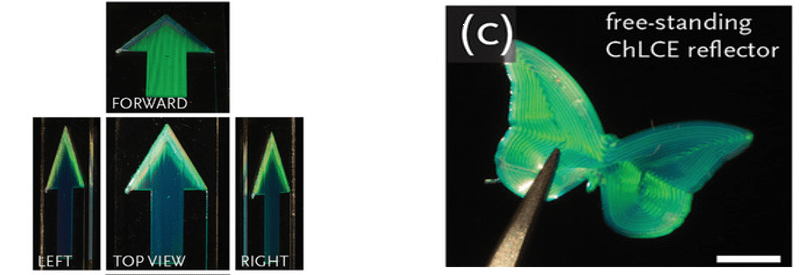If you think at all about liquid crystals, you probably think of display technology. However, researchers have worked out a way to use an ink-jet-like process to 3D print iridescent colors using a liquid crystal elastomer. The process can mimic iridescent coloring found in nature and may have applications in things as diverse as antitheft tags, art objects, or materials with very special optical properties.
For example, one item created by the team is an arrow that only appears totally green when viewed from a certain angle. The optical properties depend on the thickness of the material which, being crystalline, self-organizes. Controlling the speed of deposition changes the thickness of the material which allows the printer to tune its optical properties.
The ink doesn’t sound too exotic to create, although the chemicals in it are an alphabet soup of unpronounceable organic compounds. At least they appeared available if you know where to shop for exotic chemicals.
The iridescent coloring is common in nature, so art objects like butterfly wings are natural with this method. While inkjet printers aren’t common in the hacker community, they aren’t that hard to create, so this seems like it would be repeatable in a garage lab.
Liquid crystals have all kinds of interesting properties and we wonder if this material would help you print those sorts of things. If you want to experiment, we have seen a few hacked inkjet printers.
Thanks [jscotta] for the tip.
















Impressive. If they can do Folgers crystals they’ll have the market cornered.
“Foldgers Crystals… coffee good enough to replace human blood!”
-old SNL “commercial”
waiting for the day we can print integrated circuits at home…..
Well then, you may want to consider moving into a fab
he would but the rent is outrageous. they charge by the mm.
I think the most realistic route to that is through synthetic biology. If we could make a “DNA-synthesace” protein complex, that’s like DNA polymerase but reads some sort of signal (colored lights?) instead of a template strand to synthesize DNA in-vivo, we could realize the dream of the Rep-rap project and make a true replicating rapid-protyper.
We could then use biology as a bootstrap to a more universal form of codified molecular self-assembly which is like the holy grail of nano technology.
Then you could make fpga-like logic cells that aggregate into a sort-of field-programable compute substrate.
Synthetic biologists have already demonstrated growing batteries and solar cells in a petri-dish, why not ICs and nano-materials with exotic properties?
Once you close the loop of building the tools of synthetic biology using synthetic biology, you open the door for exponential progress (especially if it’s all open-source). People could use a crude implementation of DNA synthesace to develope increasingly refined designs of DNA synthesace and grow computers they need to compile abstract designs into DNA code and grow the solar cells and batteries etc. they need to power those computers. And on and on.
This is starting to sound suspiciously like the technology known as Proteopape from the cyberpunk short story “What’s Up, Tiger Lily” by Paul Di Filippo.